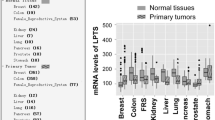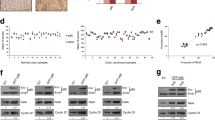Abstract
NF-κB consists of p50, p65 (RelA), p52, c-Rel, and RelB, and among them p65 is a representative protein to investigate the regulation and function of this signaling. NF-κB integrates inflammation and carcinogenesis and regulates the expression of a variety of genes in response to immunity, inflammation, and apoptosis. IκBα acts as an inhibitor of NF-κB through forming an inactive NF-κB/IκBα complex. Pokemon is a ubiquitous transcription factor involved in different signaling pathways, playing a pivotal role in cell proliferation, anti-apoptosis, embryonic development, and maintenance. In this study, we found that p65 and IκBα are both novel regulatory targets of Pokemon. Ectopic expression of Pokemon in immortalized liver cells HL7702 enhanced p65 and IκBα expression, whereas silencing of Pokemon in hepatocellular carcinoma cells QGY7703 reduced cellular p65 levels. ChIP assay and targeted mutagenesis revealed that Pokemon directly binds to the element of −434 to −430 bp in p65 promoter and of −453 to −448 bp in IκBα promoter and stimulates luciferase reporter gene expression. Co-transfection of Pokemon with p65 or IκBα promoter-reporter notably enhanced their promoter activity. These data suggest that Pokemon activates the expression of both p65 and IκBα by sequence-specific binding to their promoters and plays a dual role in regulating NF-κB signaling.






Similar content being viewed by others
References
Sen R, Baltimore D (1986) Inducibility of kappa-immunoglobulin enhancer-binding protein Nf-kappa-B by a posttranslational mechanism. Cell 47(6):921–928. doi:10.1016/0092-8674(86)90807-X
Huxford T, Huang DB, Malek S, Ghosh G (1998) The crystal structure of the I kappa B alpha/NF-kappa B complex reveals mechanisms of NF-kappa B inactivation. Cell 95(6):759–770. doi:10.1016/S0092-8674(00)81699-2
Kunsch C, Ruben SM, Rosen CA (1992) Selection of optimal kappa-B/Rel DNA-binding motifs: interaction of both subunits of Nf-kappa-B with DNA is required for transcriptional activation. Mol Cell Biol 12(10):4412–4421
Ghosh S, Karin M (2002) Missing pieces in the NF-kappa B puzzle. Cell 109:S81–S96. doi:10.1016/S0092-8674(02)00703-1
Chariot A (2009) The NF-kappa B-independent functions of IKK subunits in immunity and cancer. Trends Cell Biol 19(8):404–413. doi:10.1016/j.tcb.2009.05.006
Davis M, Hatzubai A, Andersen JS, Ben-Shushan E, Fisher GZ, Yaron A, Bauskin A, Mercurio F, Mann M, Ben-Neriah Y (2002) Pseudosubstrate regulation of the SCF beta-TrCP ubiquitin ligase by hnRNP-U. Genes Dev 16(4):439–451. doi:10.1101/gad.218702
Lee DK, Kang JE, Park HJ, Kim MH, Yim TH, Kim JM, Heo MK, Kim KY, Kwon HJ, Hur MW (2005) FBI-1 enhances transcription of the nuclear factor-kappa B (NF-kappa B)-responsive E-selectin gene by nuclear localization of the p65 subunit of NF-kappa B. J Biol Chem 280(30):27783–27791. doi:10.1074/jbc.M504909200
Davies JM, Hawe N, Kabarowske J, Huang QH, Zhu J, Brand NJ, Leprince D, Dhordain P, Cook M, Morriss-Kay G, Zelent A (1999) Novel BTB/POZ domain zinc-finger protein, LRF, is a potential target of the LAZ-3/BCL-6 oncogene. Oncogene 18(2):365–475. doi:10.1038/sj.onc.1202332
Kukita A, Kukita T, Ouchida M, Maeda H, Yatsuki H, Kohashi O (1999) Osteoclast-derived zinc finger (OCZF) protein with POZ domain, a possible transcriptional repressor, is involved in osteoclastogenesis. Blood 94(6):1987–1997
Pessler F, Pendergrast PS, Hernandez N (1997) Purification and characterization of FBI-1, a cellular factor that binds to the human immunodeficiency virus type 1 inducer of short transcripts. Mol Cell Biol 17(7):3786–3798
Collins T, Stone JR, Williams AJ (2001) All in the family: the BTB/POZ, KRAB, and SCAN domains. Mol Cell Biol 21(11):3609–3615. doi:10.1128/MCB.21.11.3609-3615.2001
Maeda T, Hobbs RM, Merghoub T, Guernah I, Zelent A, Cordon-Cardo C, Teruya-Feldstein J, Pandolfi PP (2005) Role of the proto-oncogene Pokemon in cellular transformation and ARF repression. Nature 433(7023):278–285. doi:10.1038/nature03203
Ye BH, Lista F, Lo Coco F, Knowles DM, Offit K, Chaganti RS, Dalla-Favera R (1993) Alterations of a zinc finger-encoding gene, BCL-6, in diffuse large-cell lymphoma. Science 262(5134):747–750. doi:10.1126/science.8235596
Chen Z, Brand NJ, Chen A, Chen SJ, Tong JH, Wang ZY, Waxman S, Zelent A (1993) Fusion between a novel Kruppel-like zinc finger gene and the retinoic acid receptor-alpha locus due to a variant t(11;17) translocation associated with acute promyelocytic leukaemia. EMBO J 12(3):1161–1167
Nakayama K, Nakayama N, Davidson B, Sheu JJC, Jinawath N, Santillan A, Salani R, Bristow RE, Morin PJ, Kurman RJ, Wang TL, Shih IM (2006) A BTB/POZ protein, NAC-1, is related to tumor recurrence and is essential for tumor growth and survival. Proc Natl Acad Sci USA 103(49):18739–18744. doi:10.1073/pnas.0604083103
Maeda T, Merghoub T, Hobbs RM, Dong L, Maeda M, Zakrzewski Z, van den Brink MRM, Zelent A, Shigematsu H, Akashi K, Teruya-Feldstein J, Cattoretti G, Pandolfi PP (2007) Regulation of B versus T lymphoid lineage fate decision by the proto-oncogene LRF. Science 316(5826):860–866. doi:10.1126/science.1140881
Nakayama K, Nakayama N, Wang TL, Shih IM (2007) NAC-1 controls cell growth and survival by repressing transcription of Gadd45GIP1, a candidate tumor suppressor. Cancer Res 67(17):8058–8064. doi:10.1158/0008-5472.CAN-07-1357
Zu XY, Ma J, Liu HX, Liu F, Tan CY, Yu LL, Wang J, Xie ZH, Cao DL, Jiang YY (2011) Pro-oncogene Pokemon promotes breast cancer progression by upregulating survivin expression. Breast Cancer Res 13(2):R6. doi:10.1186/bcr2843
Acknowledgments
We thank the financial support from the Ministry of Science and Technology of China (2012ZX09506001-010, 2012CB722605, 2012AA020305 and 2011DFA30620).
Author information
Authors and Affiliations
Corresponding author
Electronic supplementary material
Below is the link to the electronic supplementary material.

11010_2012_1445_MOESM1_ESM.jpg
Fig. S1 Putative motif analysis of p65 (a) and IκBα (b) is demonstrated as underlined. The transcriptional start site is bolded and indicated as +1, and the translational start codon is underlined and bolded. (JPEG 356 kb)
Rights and permissions
About this article
Cite this article
Zhang, NN., Sun, QS., Chen, Z. et al. Homeostatic regulatory role of Pokemon in NF-κB signaling: stimulating both p65 and IκBα expression in human hepatocellular carcinoma cells. Mol Cell Biochem 372, 57–64 (2013). https://doi.org/10.1007/s11010-012-1445-1
Received:
Accepted:
Published:
Issue Date:
DOI: https://doi.org/10.1007/s11010-012-1445-1




